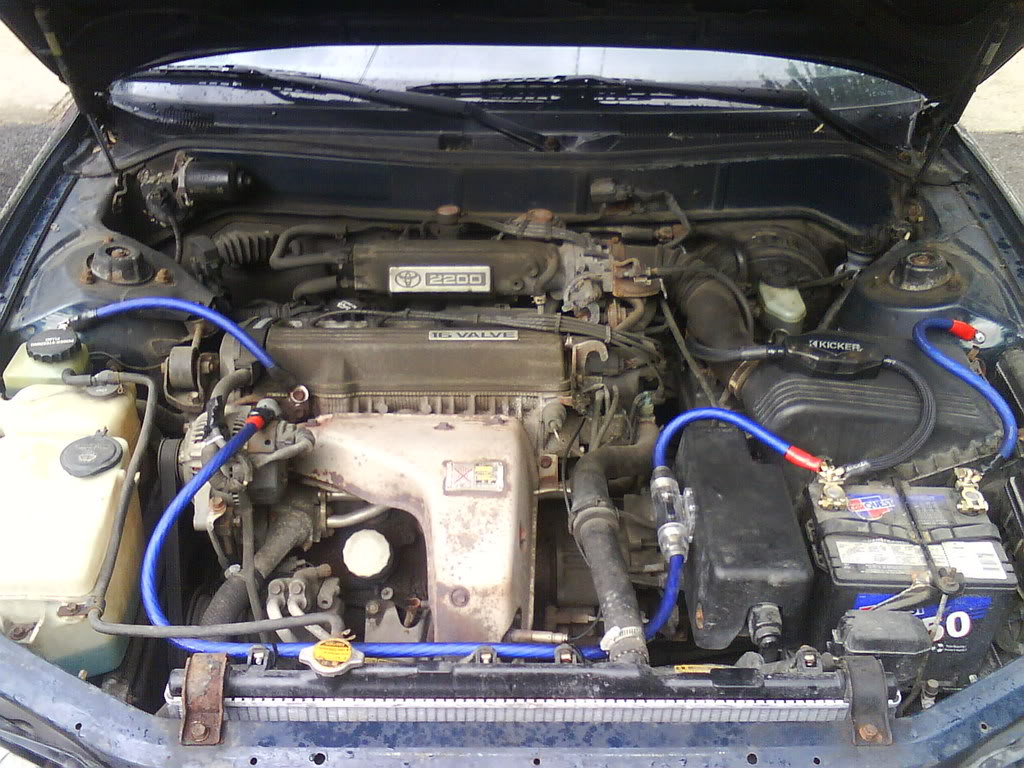The "Big 3" is a very easy upgrade to your car's electrical system that will help to reduce voltage drop for power-hungry amplifiers. If you've ever measured your voltage drop when playing music with the volume to the max with your engine running, you'll see that instead of reading 14.4v or 13.8 (depending on car), your voltmeter will read 13v, 12v, or even lower! You can easily tell if you're experiencing these voltage drops by watching your headlights. If they dim while playing your system, you may be experiencing voltage drops caused by your alternator being too small, and your wiring being too small to allow clean, sufficient current flow. This voltage drop could potentially cause harm to your amplifier and speakers if it is significant enough
I recommend using 1/0 gauge wire. You could use 4 gauge wire if that's all you have lying around, but you might as well use 1/0 the first time so you won't have to replace the wire if you decide to upgrade your system later on down the road. You will also need an in-line fuse holder and fuse rated for equal to or more than the peak current draw for the entire system and the car itself. 200-300A is usually sufficient, 1/0 ring terminals to terminate the ends of the wire, and battery terminals and adapters to connect the large gauge wire to your car battery. These are available from many manufacturers including, but not limited to such brands as Stinger, Phoenix Gold, Tsunami, Lightning
Audio, Streetwires, KnuKonceptz, and more.
Before you do anything, make sure to be safe. Disconnect the wire from the negative terminal of your battery before you begin. This makes an incomplete circuit and keeps you safe from sustaining electrical injuries, or damaging sensitive electronics within the car itself.
First, measure a length of wire to go from your battery positive (+) terminal to your alternator. Make sure to leave a little bit of slack, around 6 inches, so you'll be able to position the cable freely. Terminate the ends of the cable with ring terminals, then install the in-line fuse holder in the center of the wire, half way between each end of the wire.
This fuse will protect your car from fire in case any portion of the wiring comes loose or is severed or melted and comes in direct contact with the car chassis causing a dead short. Now, connect the wire from battery positive (+) terminal to your alternator. There may be a plastic tab on the alternator post. If there is, go ahead and break it off. If you don't remove the plastic tab, you won't be able to remove the nut from the terminal post.
The next step is to run a wire from your engine block to your car's chassis. This step may be difficult because you may have a hard time finding a place on the engine block to attach your wire. Look for a non-essential bolt; do not use a bolt that holds fluids back or requires a specific torque setting such as a head bolt. Also, avoid high heat areas such as those close to an exhaust manifold.
From there, you then need to attach the other end of the wire to your chassis ground location. This ground can be anywhere on your car's chassis/frame, but make sure that you have metal-to-metal contact with the terminal and your ground location. A good start is to follow your stock ground wire back to its grounding location. If there is paint on the ground location you have chosen, you must sand it off until it is bare metal to ensure minimal electrical resistance. It is important to leave some slack in this wire as well, because as the engine torques during use, it will move in the engine mounts relative to the inner fenders nd subframe. If there is no slack, when the engine does torque, the wire will be pulled loose, and a dead short will result, possibly causing a fire in the engine compartment.
Lastly, the final step is to run a wire from your battery's ground (-) terminal to the ground location on the chassis.
Measure the wire and be sure to leave a little slack in case you need it. Then terminate the ends with ring terminals and attach one end to the negative terminal and the other to your grounding location on your chassis (as seen above).
When you think you're finished, go ahead and double check all of your connections making sure that they are snug and tight. When the engine is hot, the wires will become softer and more supple. This can cause the wires to droop or sag, and possibly come into contact with hot engine surfaces. If this looks like it may be an issue, I recommend you use some plastic wire-ties to secure the large gauge power and ground wires to other, near-by hoses that are made of hard rubber or metal, but that do not carry hot fluids (radiator lines for example, or oil lines.)
That's it! The "Big 3" is now finished. You should notice a difference in voltage when playing your system at max volume. The "Big 3" is considered the first electrical upgrade you should do to ensure consistent power to your amplifiers.
|

